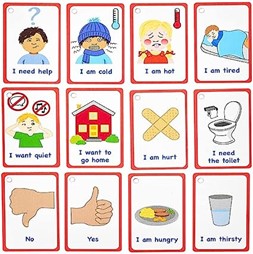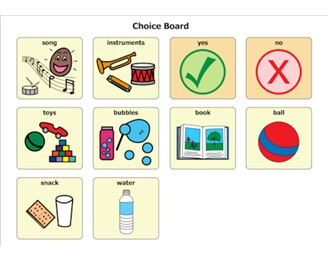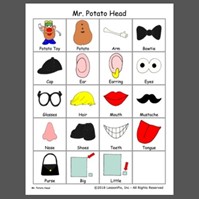Description of the video:
0:01
hi I'm Amy Gaffney I'm an educational
0:04
consultant and a speech-language
0:06
pathologist with the Indiana Resource
0:08
Center for Autism
0:09
today I want to give you a few tips on
0:12
working with your child to help increase
0:13
their communication skills children
0:16
learn communication from their parents
0:18
and caregivers so what we communicate
0:21
with our children is very important some
0:24
ways to support communication are the
0:27
following
0:28
we want to gain our child's attention
0:30
using favorite toys and activities if
0:33
they're carrying around their favorite
0:35
Disney characters you might come up and
0:38
say oh hi Mickey how are you today or
0:42
howdy partner when you see Woody you
0:46
might offer if if your child is holding
0:48
Mickey and Woody maybe you're going to
0:50
offer Rex and say hey can I play can I
0:55
join in
0:57
what are we going to do today and see if
1:00
they will respond in some way either by
1:02
taking
1:03
um Rex to add to their collection of the
1:05
little toys or maybe say something back
1:07
to you to answer a question being silly
1:11
is also a really good way to get kids
1:13
attention and to get them involved in
1:16
talking while they're playing
1:18
we want to point out people and things
1:21
that we see throughout the day and make
1:23
comments so that we're modeling for our
1:26
children some things that we can say if
1:28
we're eating oh something tastes sour or
1:32
oh that was really crunchy mmm yum yum I
1:36
like that if we're playing with a ball
1:39
or we're shooting some hoops we're we
1:41
can say great job or oh swish oh bummer
1:46
maybe next time
1:48
we use lots of gestures and we can be
1:51
very animated well during play while
1:54
we're outside taking a walk we can point
1:56
to things and look at that and see if
1:59
your child will look at you and look at
2:01
what you're pointing at and then we can
2:03
show them different things and we want
2:04
to communicate how we feel about things
2:06
that are around us
2:09
talk about what you're doing if you are
2:11
in the kitchen and you're making muffins
2:14
and your child is helping you mix and
2:16
stir the batter you can say mix mix mix
2:20
mix the batter for our blueberry muffins
2:23
mix mix and we want to emphasize those
2:26
verbs and those action words we're
2:28
mixing or maybe we want to emphasize
2:31
those blueberries are yummy ah blueberry
2:36
muffins yum yum
2:39
we also want to listen and respond to
2:42
when our child makes attempts to talk to
2:45
us
2:45
you want to make sure that you're giving
2:47
your child good eye contact
2:49
when we're talking with each other we
2:52
naturally do some non non-verbal um body
2:55
language so we nod our heads when we're
2:58
talking we smile oh
3:03
really tell me more
3:06
hmm and we really want to get engaged in
3:09
what they're talking to even if we're
3:11
not quite sure what they're saying but
3:14
they are really trying to communicate
3:15
something with us we want to encourage
3:18
that
3:19
we can also play games with our kids
3:21
some fun games that work on
3:23
communication skills are what's in Ned's
3:26
head you can you put your your hands in
3:29
this big plush head and pull different
3:31
things out you could say oh that feels
3:34
soft or ooh that feels prickly that
3:37
feels slimy yuck
3:39
um another one of my favorites is pop-up
3:42
pirate we push the little swords in and
3:45
we wait for the pirate to pop up so
3:47
there's a lot of anticipation so we're
3:49
looking at each other looking to see
3:51
what's going to happen
3:53
is it gonna pop here he goes pop up and
3:56
you put the sword in and you say oh
3:58
bummer he didn't pop up or he popped
4:03
um we can go fishing and you can talk
4:04
about my turn your turn go fish I caught
4:10
one I caught a red fish
4:13
I caught a blue fish
4:16
we know that many of our children with
4:18
autism are visual Learners so we also
4:21
want to include using pictures and
4:23
offering choices to help them be able to
4:26
communicate things to us so one of the
4:28
ways that we can do this is by having
4:31
some kind of a board and we can
4:33
communicate choices like a snack time or
4:39
you know what we want to tell the child
4:41
you need to go get dressed it's time to
4:44
get dressed
4:45
maybe we want to give them some choices
4:48
of you know do you want to watch TV or
4:51
do you want to have snack now
4:53
so those are different ways that we can
4:54
use pictures to communicate with our
4:58
children and it's a way that they can
5:00
communicate back to us
5:03
another thing that we can do to help
5:05
really work on communication and
5:07
comprehension skills for our kids
5:09
because we want to make sure that they
5:11
are understanding what we're
5:12
communicating to them so we can do a
5:15
first then schedule and I'll say first
5:19
we're going to go to the park
5:21
then we're going to go to Dairy Queen
5:23
and get some ice cream and if I don't
5:25
have a picture of Dairy Queen or some
5:27
ice cream I can just draw it on a sticky
5:29
note and put it on my card so first go
5:33
to the park then go to Dairy Queen I
5:36
might say when we get to Dairy Queen or
5:38
when we get to our favorite ice cream
5:40
place maybe it's Baskin Robbins and you
5:43
want to say what flavor do you want
5:45
you want to teach your child to either
5:47
point to the flavor that they want give
5:50
them a few choices or have them say you
5:55
know chocolate vanilla strawberry
5:56
whatever their favorite is maybe it's
5:58
the Superman
6:00
um so there's lots of different ways
6:03
that we can communicate and teach
6:05
communication to our children
6:08
we want to be very interested and very
6:11
excited about any op any attempts that
6:13
they make to communicate with us because
6:15
we want them to do with that more and
6:18
more so making sure that we take the
6:20
time to be very purposeful and think
6:22
about are we giving them the attention
6:24
that they need are we helping to support
6:27
their communication and if they're not
6:30
wanting to communicate with us very
6:31
often how can we gain their attention
6:34
how can we use some of their favorite
6:36
things to maybe if you want to to play a
6:40
little ball
6:41
a little toss game with them you want to
6:44
roll the ball over to them or you hand
6:47
them the little paddle and then they'll
6:51
look to you like why are you giving me
6:53
this and then you can say
6:54
couch couch
6:58
and then see wait a second and offer
7:01
them the ball and see if they will
7:04
respond back and say catch or yes or
7:07
let's play
7:09
fun okay let's go
7:13
um also using repetitive phrases like
7:16
Ready Set Go
7:20
and when we say that many times over and
7:23
eventually all of a sudden if you listen
7:25
real carefully sometimes we start
7:27
hearing those little voices say go
7:31
Ready Set
7:34
and then we wait and they'll say it all
7:37
by themselves go
7:39
there's lots of fun ways that we can
7:42
interact with our children and work on
7:44
their back and forth communication
7:45
skills I hope some of these tips are
7:48
helpful to you and your family




